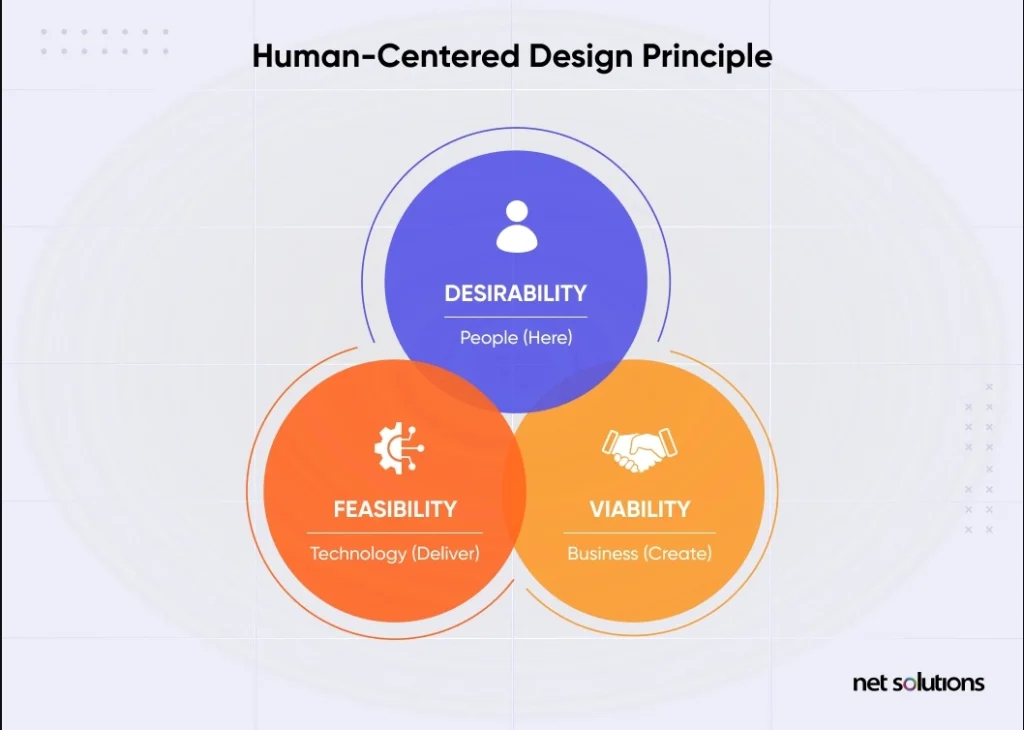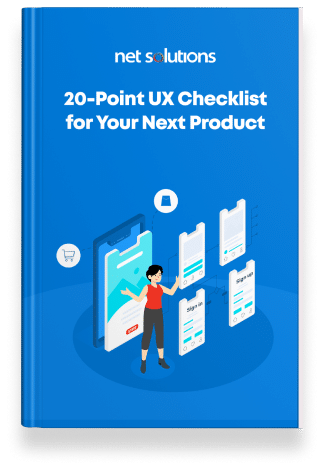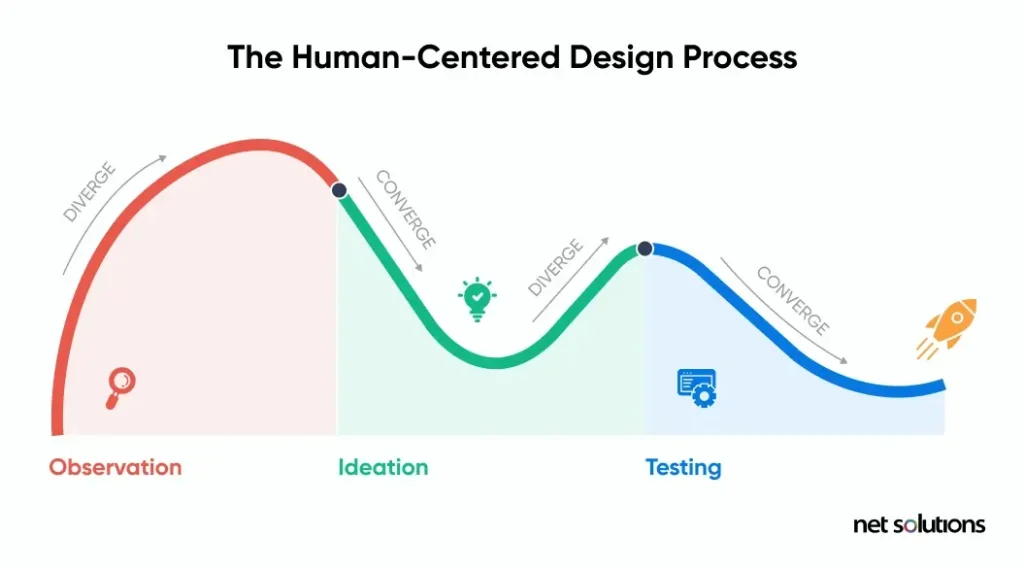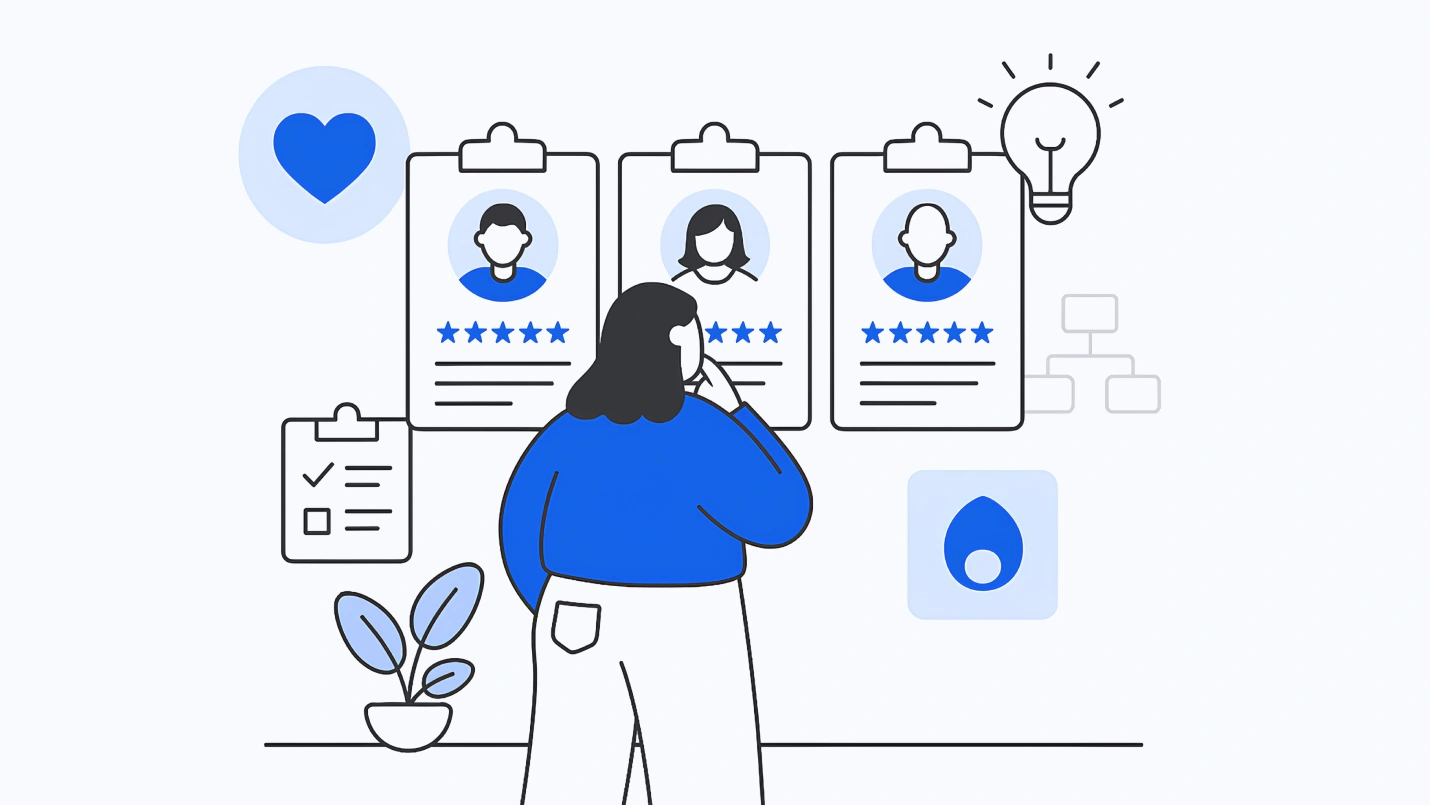Picture this: A user experience design approach that isn’t just about crafting visually appealing products but about understanding the core of human needs, desires, and aspirations. This isn’t your typical design discourse – this is Human-Centered Design (HCD) in all its glory.
Human-Centered Design (HCD) is a mindset used to design experiences for people. It co-creates solutions with the people who require them most. Involving target users while we design solutions to make their lives better is an essential part of the Human-Centered Design process.
“Usability is like love. You have to care, you have to listen, and you have to be willing to change. You’ll make mistakes along the way, but that’s where growth and forgiveness come in.” -Jeffrey Zeldman
What (exactly) is Human-Centered Design?
“Human-Centered Design is a framework that considers human perspectives throughout the design process.” – Francesca Sciandra, Product design lead and design educator
IDEO, a global design company, launched the Human-Centered Design Toolkit, an innovative toolbox that guides designers. IDEO’s HCD Toolkit has over 150,000 copies downloaded by designers, innovators, entrepreneurs, and analysts – who use it to improve their products and systems with a Human-Centered Design approach.

Four Principles Of a Human-Centered Design
- People-centered: HCD puts the needs and experiences of people at the center of the design process. This means that the UX design services of any business will emphasize understanding the people using the product or service, their goals, and their pain points. It also means involving them in the design process as much as possible so that their voices and needs are heard.
- Understand and solve the correct problems, the root problems: HCD is not about just fixing the symptoms of a problem. It’s about understanding the root cause of the problem and designing a solution that addresses that root cause. This requires deep empathy and understanding of the people experiencing the issue.
- Everything is a system: HCD recognizes that everything is connected. A product or service does not exist in isolation. It is part of a more extensive system, such as an organization, an industry, or a community. HCD takes this into account when designing solutions so that the solution has a positive impact on the entire system.
- Small and simple interventions: HCD often starts with small and simple interventions. Testing and iterating on small changes is easier than on large ones. It also allows for more flexibility and adaptability.

We respect your privacy. Your information is safe.
How to Focus on People When You Solve Complex Global Challenges?
Here are some tips on how to focus on people when you solve complex global challenges:
- Empathize with the people affected by the challenge: This means putting yourself in their shoes and understanding their experiences, needs, and priorities. You can do this by talking to them, observing them, and reading about their experiences.
- Understand the root cause of the challenge: What are the underlying factors that are causing the problem? Once you understand the root cause, you can start to develop solutions that address it.
- Involve the people affected by the challenge in the solution process: This is essential to ensure that the solutions are relevant and practical. The people most affected by the problem are often the best to come up with solutions.
- Be flexible and adaptable: Complex global challenges are often complex and ever-changing. Be prepared to adapt your solutions as needed.
- Measure the impact of your solutions: This will help you to understand whether your solutions are making a difference.
The Human-Centered Design Process

Phase 1: Inspiration
- Explore and observe:This phase is all about understanding the people who will be using the product or service. This includes understanding their needs, pain points, and goals. You can do this by talking to them, observing them, and conducting research.
- Define the point of view: Once you understand the people using the product or service, you need to define the point of view. This statement captures the essence of the problem you are trying to solve.
Phase 2: Ideation
- Ideate: This phase is all about coming up with ideas for solutions to the problem. You can do this by brainstorming, sketching, and prototyping.
- Prototype: Once you have some ideas, you need to prototype them. This means creating a rough version of the solution so that you can test it out and get feedback.
- Test: Once you have a prototype, you must test it with the people using it. This will help you identify any problems with the solution and improve.
Phase 3: Implementation
- Develop: Once you have a solution you are happy with, you need to develop it. This means turning it into a finished product or service.
- Deliver: Once the product or service is developed, you must deliver it to the people using it.
- Evolve: Once the product or service is used, you must continue evolving it. This means making changes based on feedback from users and the changing needs of the market.
Human-Centered Design Examples
1. Spotify
Have you ever thought about how Spotify disrupted the music industry? Why does it still stand out when tons of applications mimic its services?
Here is the answer: Spotify made it easier and cheaper to listen to music.
Spotify is the first primary streaming service that allows people to collect and stream music instead of buying it. Thanks to Spotify, people no longer have to buy $0.99 or $1.99 songs – with a monthly subscription model that gives millions of songs on Spotify, we can search for a piece and play it.
2. Colgate
Colgate had a monopoly back in the 1990s for electric brushes. But they lost their grip on the market. Their market research discovered that their target customers were below 20 and were looking for a slimmer toothbrush. Their research led to a solution that took their “Acti-Brush” from number four back to number one.
3. Airbnb
Airbnb revolutionized the hospitality and travel industry by embracing Human-Centered Design principles. The company recognized that many travelers sought unique and authentic experiences beyond traditional hotels. They identified a gap in the market for personalized accommodations and local interactions.
Airbnb’s platform allows individuals to rent out their homes, rooms, or other spaces to travelers. This provides travelers a more personalized experience and empowers hosts to monetize unused spaces. Here’s how Airbnb exemplifies Human-Centered design:
- User Empathy: Airbnb deeply understood the pain points of both travelers and hosts. Travelers were looking for accommodations that felt like home, while hosts wanted to make extra income. By addressing both sides’ needs, Airbnb created a win-win situation.
- Personalization: The platform’s design emphasizes choice and personalization. Travelers can filter accommodations based on their preferences, such as location, amenities, and budget. This customization enhances the user experience and makes finding the perfect place to stay easy.
- Trust and Safety: Airbnb tackled the issue of trust between hosts and guests through features like reviews, ratings, and verified user profiles. This Human-Centered approach helps users feel more secure about their choices, fostering a sense of community and reliability.
- Collaborative Economy: Airbnb taps into the sharing economy concept, where people can share resources they have in excess. This approach aligns with modern consumers’ changing behaviors and values, who often prioritize experiences over ownership.
- Inclusive Design: Airbnb’s platform is designed to accommodate a wide range of users, including those with accessibility needs. This commitment to inclusivity helps ensure that as many people as possible can benefit from the service.
- Continuous Improvement: Airbnb actively collects feedback from hosts and guests, using this information to refine its platform and services. This iterative approach reflects a commitment to ongoing improvement based on real user experiences.
Human-Centered Design Tools
HCD tools are usually frameworks, methods, or processes teams can follow to create a human-centric design. These tools accommodate Human-Centered design principles, allowing businesses to solve problems faster with design.
1. The Field Guide to Human-Centered Design
IDEO, the company that created the HCD Toolkit, later authored a book on the same topic to guide professionals. The Field Guide to Human-Centered Design is a step-by-step guide that will help you solve problems like a designer.
2. Design Sprint
A design sprint is a weekly (5-day) process used for solving critical business problems with the help of design, followed by prototyping and testing prototypes with real people. With a focus on mapping problems, ideating for solutions, and testing for validity – design sprints are used by companies worldwide to empower users.
3. Development Impact & You
Development Impact & You or DIY is a list of tools to help busy people invent, adopt, or adapt ideas for better results. These tools are excellent for co-creating solutions that involve social change.
Human-Centered Design is All About Empathy
Empathy is the ability to understand and share the feelings of another person. In the context of HCD, empathy is essential for understanding the users’ needs and challenges. It requires designers to put themselves in the users’ shoes and see the world from their perspective.
There are many ways to practice empathy in HCD. Some common methods include:
- User interviews are a great way to know the users and their needs. During a user interview, the designer will ask the user about their experiences, challenges, and goals.
- Observation involves watching the users interact with the product or service in their natural environment. This can help the designer understand how the users use the product or service and where improvement opportunities exist.
- Prototyping involves creating a low-fidelity version of the product or service to test with users. This can help the designer to get feedback on the design and make changes before the final product is created.
How Can Net Solutions Help You Curate Human-Centered Design Products?
Net Solutions is here to guide you through the process of curating Human-Centered Design solutions. Explore our portfolio and client success stories to witness how we’ve helped businesses like yours achieve exceptional user experiences.

Net Solutions designed and built a nimble app for Drive Focus with technology capable of expanding beyond its original aims. The app was originally intended to be a video driving course that simulates the driving experience using interactive video. However, Net Solutions expanded the app’s features to accommodate a wider range of uses for its cognitive training technology. This helped to create a product with broader appeal.
Contact us to discuss your unique design needs and discover how we can collaborate to create products that resonate with your audience. Let’s bring your vision to life through thoughtful design.
Frequently Asked Questions
- Affinity mapping
- Card sorting
- Co-design
- Contextual inquiry
- Desktop research
- Design sprint
- Diary study
- Ethnographic research
- Desirability
- Feasibility
- Viability
Empathy, expansive thinking, and experimentation.





